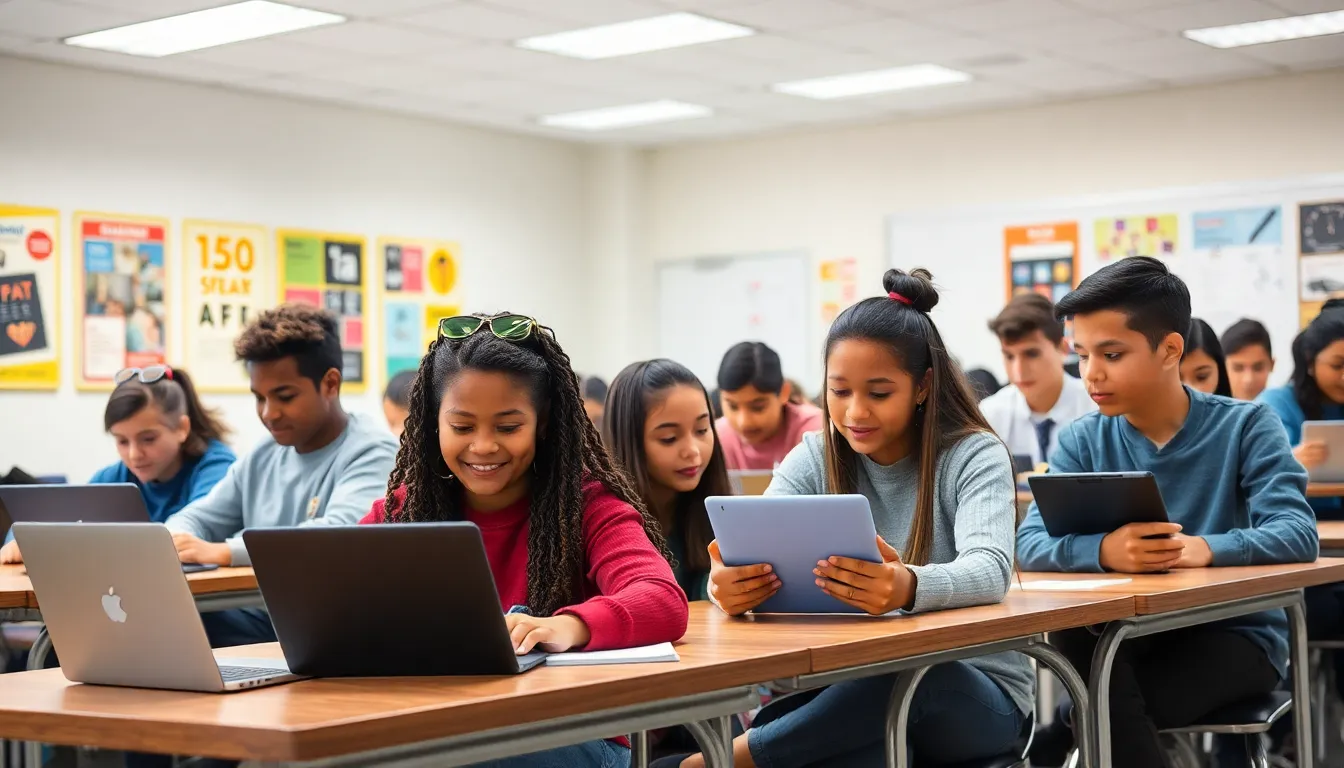In today’s fast-paced world, education is evolving faster than a student can say “pop quiz.” Emerging technologies are shaking up traditional classrooms and transforming how knowledge is shared. From virtual reality field trips to AI tutors that never forget a student’s name, the future of learning is as exciting as it is innovative.
Table of Contents
ToggleOverview of Emerging Technologies in Education
Emerging technologies are transforming education by introducing innovative tools and approaches. Virtual reality (VR) enhances classroom experiences by immersing students in interactive environments. Augmented reality (AR) enriches real-world lessons, providing additional information and context through digital overlays. Artificial intelligence (AI) personalization adapts learning plans to fit individual student’s needs, ensuring improved engagement and understanding.
Mobile applications facilitate on-the-go learning, allowing students to access resources anywhere and anytime. Learning management systems (LMS) streamline course administration and track student progress through data analytics. Gamification of education motivates students with game-like elements, making learning enjoyable while fostering deeper understanding.
Data analytics enables educators to assess methods and identify areas for improvement. Cloud computing simplifies access to educational resources, encouraging collaboration and resource sharing among educators and students alike. Robotics introduces hands-on learning opportunities, engaging students in STEM subjects and fostering skills necessary for future careers.
The integration of these technologies promotes inclusivity and accessibility for diverse learners. Adaptive learning tools transform traditional teaching into personalized education experiences. Further, online platforms expand availability, allowing learners across the globe to connect with expert instructors. The collaboration between various educational technologies promises a future where learning becomes a more dynamic, engaging, and customized experience for all students.
Benefits of Emerging Technologies

Emerging technologies significantly enhance education by providing numerous advantages for students and educators alike.
Enhanced Accessibility
Emerging technologies improve accessibility within educational settings. Students with disabilities benefit from tools like screen readers and speech recognition software. These innovations enable equitable access to resources and materials. Virtual learning environments cater to diverse learning needs, allowing students to engage from any location. Educational platforms adapt content presentation, ensuring information reaches every student. Online resources provide flexibility, enabling learners to study at their own pace. Ultimately, emerging technologies create an inclusive atmosphere, allowing all students to participate in the learning process.
Personalized Learning Experiences
Personalized learning experiences thrive with the integration of technology in education. Adaptive learning systems identify individual strengths and weaknesses, tailoring content to fit each student’s needs. Artificial intelligence plays a crucial role, analyzing performance data to recommend targeted resources. Students enjoy a customized learning journey, enhancing motivation and engagement. This targeted approach fosters deeper understanding and retention of knowledge. Emerging technologies also facilitate real-time feedback, allowing educators to adjust instructional strategies promptly. With these advancements, personalized learning becomes more accessible and effective, promoting overall academic success.
Challenges in Implementing Emerging Technologies
Implementing emerging technologies in education presents several challenges that can hinder their effective use in classrooms.
Cost and Resource Constraints
Budget limitations often restrict the adoption of new technologies. Educational institutions face high costs for software, hardware, and ongoing maintenance. A report by the EduTech Foundation indicated that 50% of schools encounter obstacles due to budget cuts. Funding is essential for purchasing necessary tools and upgrading existing infrastructure. Without financial resources, many schools struggle to provide equitable access to technology. Grant programs and partnerships with tech companies can offer potential solutions to these financial barriers.
Teacher Training and Support
Training educators to use new technologies effectively poses another significant challenge. Many teachers feel unprepared to implement innovative tools in their instruction. A survey from the National Education Association found that 60% of educators desire additional training on technology integration. Professional development programs must be prioritized to equip teachers with skills for modern classrooms. Mentorship and ongoing support from tech-savvy colleagues can enhance teachers’ confidence and proficiency. Addressing this need fosters a smoother transition to tech-enhanced educational environments.
Notable Emerging Technologies in Education
Emerging technologies continue to revolutionize education, enhancing the learning experience for students worldwide.
Artificial Intelligence and Machine Learning
Artificial intelligence transforms education through personalized learning experiences. AI analyzes student performance data to fine-tune lesson plans. Adaptive learning systems adjust content based on individual strengths and weaknesses. These tailored approaches lead to better knowledge retention. Machine learning algorithms can identify trends in student progress, providing educators with actionable insights. As technology evolves, more schools are likely to implement AI tools. Prioritizing training for educators on these tools ensures that they can utilize AI effectively.
Virtual and Augmented Reality
Virtual reality immerses students in interactive learning environments. Students can explore historical sites or conduct scientific experiments in a virtual setting. Augmented reality overlays digital information onto the physical world, enhancing real-world lessons. These technologies engage students on multiple sensory levels, increasing motivation and understanding. Schools that incorporate VR and AR not only enrich curricula but also promote collaboration through shared experiences. Even remote learners benefit, as these tools allow access to unique educational opportunities.
Blockchain in Education
Blockchain technology offers a secure method for storing academic records. Digital credentials can be verified quickly, preventing fraud and ensuring transparency. This technology streamlines administrative processes, making it easier for institutions to manage student data. Further, blockchain can enhance online assessments by providing tamper-proof evaluation methods. Institutions that adopt blockchain stand to improve trust with students and employers. As awareness grows, more educational organizations may explore blockchain’s potential, enhancing efficiency and security across educational systems.
Future Trends in Education Technology
Emerging technologies are driving significant changes in how students engage with learning materials and how educators make informed decisions.
Student Engagement Innovations
Gamification techniques are increasingly used to capture students’ attention. By integrating game-like elements, educators motivate students to participate actively in their learning journey. Virtual reality experiences provide immersive environments that enhance understanding and retention. Tools like interactive quizzes and competitions encourage collaboration among peers. Personalized learning pathways allow students to progress at their own pace, catering to individual learning preferences. These innovations not only make learning enjoyable but also deepen comprehension through hands-on engagement.
Data-Driven Decision Making
Data analytics tools empower educators to gain insights into student performance. These tools help identify learning trends and areas for improvement, guiding instructional strategies effectively. Adaptive learning systems analyze individual data to suggest relevant resources and support. Continuous assessment generates real-time feedback, enabling teachers to adjust their approaches promptly. Such informed decision-making enhances overall educational outcomes and fosters a culture of responsive teaching. Prioritizing data-driven methods ensures that educators meet the diverse needs of their students efficiently.
The landscape of education is undergoing a remarkable transformation thanks to emerging technologies. Innovations like virtual reality and artificial intelligence are not just enhancing learning experiences but also personalizing education to meet individual needs. As these technologies become more integrated into classrooms, they promise to create more dynamic and engaging learning environments.
While challenges such as budget constraints and the need for educator training remain, the potential benefits far outweigh the obstacles. By prioritizing investment in technology and professional development, schools can ensure that all students have access to cutting-edge educational tools. The future of education is bright and filled with possibilities that can lead to greater academic success for learners everywhere.



